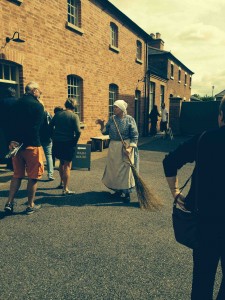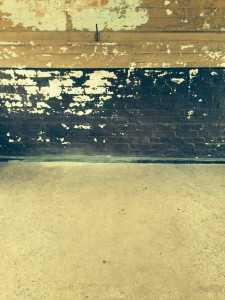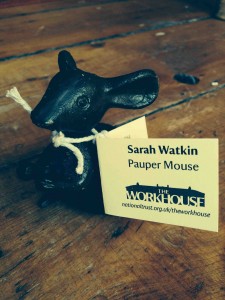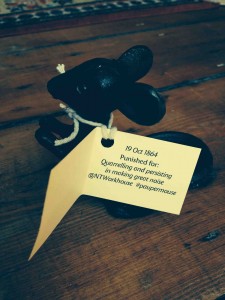Pop up paupers, pathways and pauper mice at the Workhouse, Southwell
Post by Jenny Hughes
On Sunday 24th August I went with Carran Waterfield from Triangle Theatre to the Workhouse at Southwell (Nottinghamshire). The workhouse was bought by the National Trust in 1997 and renovated with loving care and no expense spared to a condition as close to the original as possible, opening to the public in 2002. The Workhouse was bought at a time when the National Trust was the subject of public discussion about the ‘exclusiveness’ of the heritage it was preserving, and represented an determined extension of its project to include sites of that represented common, or working class, life (see for example George Monbiot’s piece in 1995 -http://www.monbiot.com/1995/09/27/whose-nation-whose-trust/).
Our visit was an inspiring experience in lots of ways, not least in providing much food for thought for a piece of solo performance, inspired in part by the workhouse system, that Carran is developing as part of the poor theatres research. This is the only workhouse in the country, to my knowledge, that is open to the public and we were also interested to go because of the opportunities to see how theatre was being used to engage the public in learning more about the site. On Sundays throughout August, there were ‘pop up paupers’ at the site, characters from the workhouse’s past, performed by a group of National Trust volunteers called ‘The Workhouse Storytellers’. Pop up paupers told visitors about their lives in the workhouse, took visitors on tours and tried to steal their sandwiches during picnics in the grounds.
The workhouse originally opened in 1824, and its success in bringing down the poor rate meant that it came to the attention of the Poor Law commission, who promoted it as an example of good practice of the amended legislation brought into law in 1834. This good practice including the ‘workhouse test’ – those needing help were offered the workhouse (rather than out-relief), which required able-bodied paupers to work in return for relief and live in conditions ‘less eligible’ than the self-sufficient working poor (and therefore sifting out those trying to access relief deceptively). My overwhelming impression on seeing this extraordinary site – even though I had read about this beforehand – related to how effectively the architecture delivered the aims of the poor law. For example ‘segregation’ was built into the architecture to prevent ‘contagion’ between the idle and vicious poor and the vulnerable populations of children and aged and infirm adults. Contagion is an interesting idea for theatre researchers – it can be linked to imitation and other modes of performance associated with the idea of ‘mimesis’ (and I’m particularly thinking of Michael Taussig’s explorations of mimesis as mobilised by ‘contact’ and copy’ in relation to contagion here – as explored in his book Mimesis and alterity). The workhouse was split into four units – from left to right as you look at the photo above – for able bodied women, aged and infirm women, aged and infirm men, able bodied men – with a dormitory for children at the back). Each unit is connected by staircases that go up and down, and any connecting corridors that go across the building from left to right are blocked by locked doors. This architectural segregation was accompanied by sight lines that allowed for surveillance – the Master’s office in the centre of the building provided a view of the yards below for example, although not into a corner of the able-bodied men’s yard, where etchings of gambling games can be still seen on the part of the wall beyond the Master’s sight-lines. Overall, the site provides a powerful impression of the odd mix of the punitive and beneficent in modes of welfare developed in the 19th century, and also into the 20th century – the final room, for example, featured a 1970s bedsit for homeless single mothers with children. The workhouse was used as a site for the desperate poor right up to this period – I wandered round the bedsit, complete with 1970s gas fire, cooking utensils etc – listening to snippets of oral testimony from local people who had spent some part of their childhood in this space.
The ‘pop up pauper’ performers offered light entertainment on the tour of the site – engaging in banter with visitors. For example, the women at the pump in the workhouse yard pictured here demanded that visitors stop staring and help them with their work, and complained about their treatment at the hands of the Master and Matron. These improvised moments were interrupted by the sudden arrivals of said Master and Matron who commanded them to return to their work. A tour, led by pop up pauper Lizzie, who worked in the workhouse kitchen, was informative, and had moments of question and answer and other kinds of engagement particularly aimed at younger visitors. The performers were happy to engage in longer conversations with visitors where they slipped in and out of character, giving explanations of their role and more detailed accounts of the site and its history. We are especially grateful for a chat with the pauper porter who provided an insight into the different periods of the workhouse from its construction right up to the present day – it became living quarters for NHS staff post 1945, and, later a training site for police dogs – the NT rescued it in the 1990s from a property developer who had gone bankrupt (many of the old workhouse sites in the country have been developed by property developers and destroyed or transformed into posh flats). He also told us to watch out for a television programme to be filmed in the workhouse shortly, where celebrities will be spending some time in the workhouse and treated as paupers!
I enjoyed the pop up paupers a great deal – but at times found their light-heartedness at odds with the harshness of the site itself. Reflecting the theatre researcher in me (and most likely not reflecting the responses of the more leisurely weekend summer visitors who want a more gentle overview of the place) – at times, I wanted the pop up paupers to make more of the contradictions of this site. This might have happened by a more precise positioning of the visitors as complicit in the spectacle of power on display, and play between various characters to further illuminate the hierarchies they were embedded in. There was a danger – without this exploration of the layers of meaning in the site – of leaving visitors with an unproblematised notion of welfare past and present. At times in encounters with the performers, for example, there was a sense of this site being an example of how difficult things were for the poor in the past compared to how easy it is for poor people today to access and life on benefits – which felt a little inaccurate and unhelpful. I also wondered whether the National Trust could do more to connect the site to contemporary debates about welfare, nationally and internationally?
The most moving moment in the visit for me was in the dormitory for able-bodied men. This had been left in the condition in which it had been found – fairly untouched since the transfer of the workhouse into the care of the NHS in 1948. The part that made me want to cry was when the conservationist speaking on the audio recorded tour invited me to look at the floor – there were grooves in the ground worn by pauper feet treading pathways between the beds over more than 100 years (you can only just see these on the photo below, but they were there). The pathways contrasted with the smoothness of the concrete next to them, which in turn illuminated the narrow, shrunken bed shapes, and looking up to the walls you see one peg for clothes or belongings above each pauper bed. Standing in these old, worn through walkways was extremely strange – and offered a tangible invitation to imagine and feel for the plight of what must have been hundreds and hundreds of poor men treading their way from bed to stone-breaking in the yard over the years.
To end by briefly describing another – more light-hearted – tangible pauper presence during the trip. At the end of the tour – on our ‘exit through the gift shop’ (to quote the Banksy film) – I bought a pauper mouse for £5, named after a real workhouse inmate identified from the punishment books in the archives. Allow me to introduce Sarah Watkin, punished for ‘quarrelling and persisting in making great noise’ on 19th October 1864 …






Comments are closed
Sorry, but you cannot leave a comment for this post.